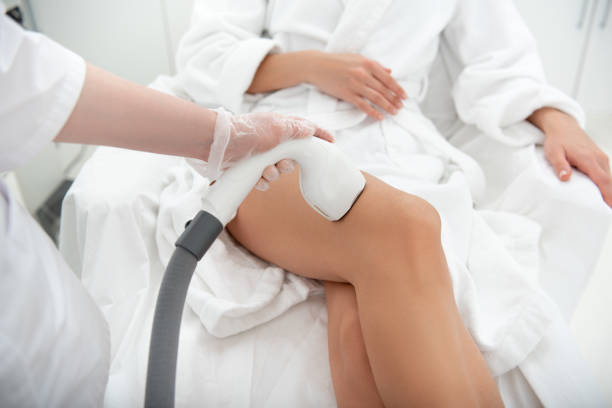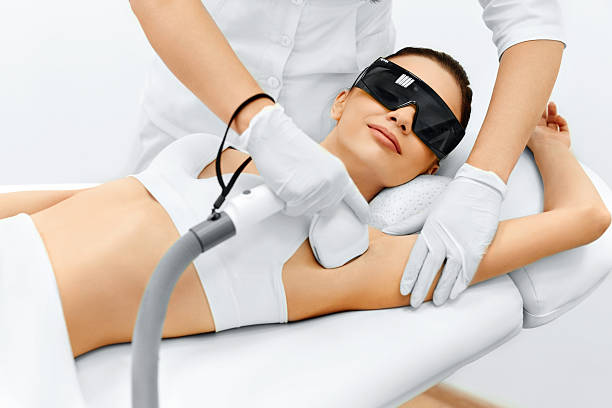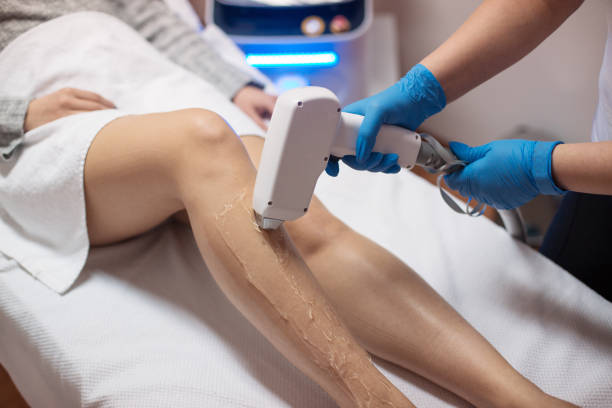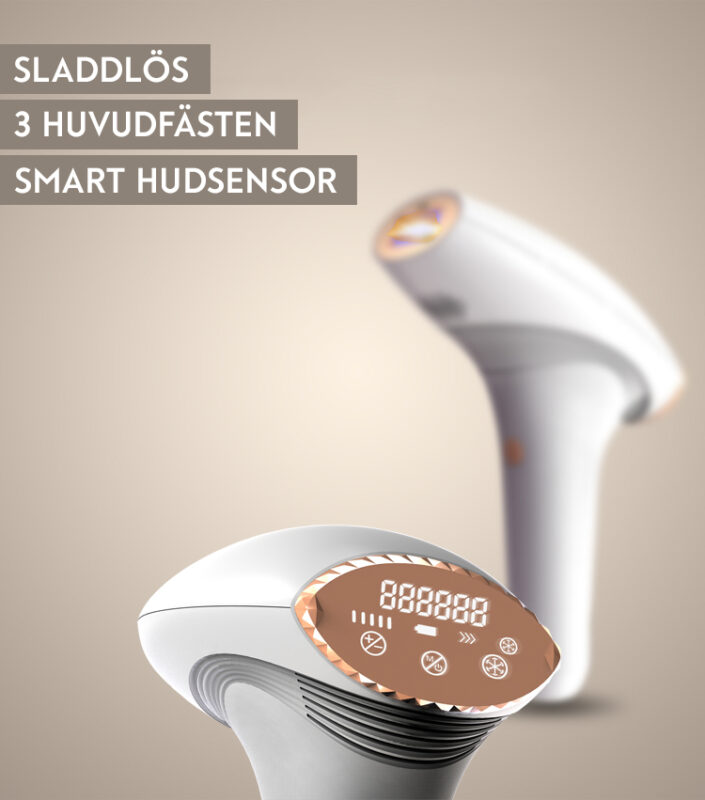Hair Removal, IPL
What is IPL treatment? We answer your questions about IPL treatment
Table of contents
What does an IPL treatment involve?
IPL-treatment is a type of light therapy which is used to treat wrinkles, stains and removal of unwanted hair. IPL stands for intense pulsating light.


You can perform IPL treatment at home to minimize or remove:
- Age spots
- Sun damage
- Freelancer
- Birthmarks
- Varicose veins
- Broken blood vessels i the face
- Rosacea
- Hair in the face, on the neck, back, chest, legs, under the arms or bikini line.
The difference between IPL and laser treatment
IPL-treatment is similar to a laser treatment. One laser however, focuses only one wavelength of light on the skin, while IPL emits light with many different wavelengths, like a photo flash.
The light from IPL is more diffused and less focused than one laser. IPL penetrates down to the second layer of the skin (dermis) without damaging the top layer (epidermis), so it causes less damage to the skin.
The pigment cells in your skin absorb the light energy, which is converted into heat. The heat destroys the unwanted pigment to remove freckles and other blemishes. Or it destroys the hair follicle to prevent hair from growing back.
You can use IPL treatment anywhere on the body, but it may not work as well on uneven areas. It is not recommended for people who tend to get raised keloids or who have darker skin tones. It is also not as effective in light hair as on darker hair.
How you should prepare for IPL treatment
Did you know that winter is the best time to start thinking about laser hair removal? Although this non-invasive cosmetic procedure can be performed throughout the year, it requires consistency as the results accumulate with each treatment; to deal with laser during the cooler months means you'll be hair-free and ready for the beach come December!
Before the IPL treatment, your dermatologist will examine your skin and inform you of the results you can expect. Let them know if you have any skin conditions that may affect healing after treatment, such as inflammatory acne or eczema.
Your dermatologist may recommend that you avoid certain activities, medications and other products for two weeks prior to treatment.
In connection with IPL treatment, you should avoid
- Direct sunlight
- Solariums
- Waxing
- Chemical peels
- Collagen injections
- Medicines that increase the risk of bleeding, such as aspirin and ibuprofen.
- Creams or other products containing vitamin A, such as RetinA, or glycolic acid.
Costs of IPL treatment
The cost depends on the type of condition you want treated and the size of the treatment area. On average, IPL treatment costs between €7,000 and €12,000 in the clinic. You may have to pay more for tests, follow-up visits or medication. As IPL treatment is considered a cosmetic procedure, most health insurance policies do not cover the cost.
What you can expect during treatment
Your skin therapist will first do the area to be treated. Then they rub a cold gel on your skin. Then they apply pulses of light from the IPL unit to the skin area. During the treatment you will need to wear dark glasses to protect your eyes.


The pulses can sting the skin. Some people liken the sensation to being squeezed with a rubber band.
Depending on which part of your body is being treated and how large the area is, the treatment should take 20 - 30 minutes.
To get the results you want, you may need three to six treatments. These treatments should be done about a month apart to allow the skin to heal between them. Hair Removal requires 6 to 12 treatments.
How well IPL treatment works
Newer IPL devices work about as well as laser treatments for some cosmetic treatments, such as reducing the appearance of blood vessels in the skin. For hair removal IPL works better on thick, dark hair than on fine, light hair. You may need several treatments to achieve the desired results.
Possible side effects
Most people experience slight redness or swelling after treatment. This usually disappears within a day or two.
In some cases, you may even experience:
- Bruises
- Blisters
- Change in skin colour.
- Infection
What you can expect after an IPL treatment
You should be able to return to your normal activities. The treated skin area will be red and sensitive for a few hours, as if you had been sunburned. Your skin may also be slightly swollen. Your skin will continue to be sensitive for a few days after treatment. You may need to avoid using hot water on it until the skin heals.
Alternatives to IPL treatment
IPL treatment is not the only method used to remove fine lines, blemishes and unwanted hair. Other options include:


Laser: A laser uses a single, focused wavelength of light to remove unwanted hair permanently at home, wrinkles, sun damage and other blemishes. If the laser removes the top layer of skin, it is considered an ablative treatment. If it heats the underlying tissue without damaging the top layer, it is considered non-ablative.
Laser treatments require fewer sessions than IPL treatment, and they can be used effectively on dark skin. The cost of laser skin resurfacing averages around €22,000.
Fraxel laser treatment: The Fraxel laser is considered a nonablative treatment because it penetrates below the skin's surface without damaging the top layer. Some Fraxel treatments treat part of the skin and can then be called fractional laser, which treats part of the skin in an ablative way. Fraxel laser can be used to treat sun damage and wrinkles as well as acne scars. After the treatment, the skin renews itself. You need several treatments to see results. Fraxel laser treatments cost around SEK 10,000 per session.
Microdermabrasion: Microdermabrasion uses a grinding machine to gently remove the top layer of skin. It can be used to bleach age spots and areas of darker skin. It can also reduce the appearance of fine lines and wrinkles. You'll need a series of treatments to see an improvement, and the results are usually temporary. The average cost of a treatment is £1,000.
Advantages and disadvantages of IPL treatment compared to other cosmetic treatments.
Benefits:
- The treatment works well to reduce wrinkles and blemishes and get rid of unwanted hair.
- Sessions are faster than with other methods.
- The light doesn't damage the top layers of skin, so you'll have fewer side effects than with laser or dermabrasion.
- Recovery is fast.
Disadvantages:
- You will need to return for several treatments to get the results you want.
- IPL does not work well on dark skin and light hair.
Discuss all your options with your dermatologist, including benefits, risks and costs, to decide whether IPL or another treatment works best for you.
What are the main differences between IPL treatment at home and IPL treatment in a clinic?
Traditionally, IPL - a treatment we have left to the professionals. But in the last five years, technology has come a long way, and now many companies offer at-home devices that promise to deliver the same results as a professional treatment.
But can a home device really compete with an IPL treatment in a clinic? Here, Hannah English, beauty writer, pharmaceutical researcher, explains the difference between the two.
IPL treatment at home
Först och främst: Hur fungerar IPL-behandling överhuvudtaget? ”IPL sänder ut intensivt pulserande ljus under huden som riktar sig mot melaninet i hårsäcken”, säger Hannah. ”Melaninet värms upp och pressar in håret i ett ’viloläge’. När håret befinner sig i denna vilofas faller det ut naturligt och hårväxtprocessen startar igen.”


Förutsatt att du investerar i en högkvalitativ IPL-apparat är behandlingen säker och effektiv att använda hemma. ”Var försiktig med var du köper från – många billigare IPL-apparater har ingen hudtonsensor, vilket innebär att användarna måste jämföra sin hudton med pappersdiagram för att ställa in energinivån. Detta lämnar det upp till användaren att göra rätt eller fel, med begränsad vägledning om rätt inställning.”
Vivre IPL for home use
For those who want to invest in their own IPL machine, the recently launched Vivre® IPL Pro Cordless Laser Hair Removal one of the most sophisticated on the market. " Vivre® IPL Pro is completely safe to use at home - it uses proprietary technology that continuously measures the differences in skin tone and automatically adjusts the light intensity to the optimal level. So it's always the perfect balance between energy and safety."
To ensure the best results, we recommend Vivre att du startar din resa med fyra till tolv behandlingar per vecka. ”Den tid det tar att se resultat varierar från person till person, beroende på deras typiska hårväxtcykel. För vissa personer kan det ta upp till 16 månader för områden som armhålor, underben och bikiniområdet.”
Med detta sagt är det värt att notera att IPL i hemmet inte är lämpligt för alla hudtyper. ”Det är mest effektivt på ljusa till medelstora hudtoner, med hår som sträcker sig från naturligt blonda till mörkbruna eller svarta hårstrån”, förklarar Hannah.
”Apparaten är så inte effektiv på väldigtt blont, rött, grått eller vitt hår – den mindre mängden melanin i dessa hårfärger absorberar inte ljusenergin. Eftersom mörk hud innehåller mer melanin kan den absorbera mer än den säkra, rekommenderade mängden ljusenergi och kan därför orsaka obehag.”
IPL treatment in clinic
Professional IPL treatment first became available for commercial use in the mid-1990s.
Tekniken som används i salong är mycket lik den som används i de tidigare nämnda hemmaapparaterna. ”Verkningsmekanismen är densamma för båda teknikerna – det vill säga att rikta in sig på melaninet i hårsäcken. När det gäller rapporterade hårborttagningsresultat finns det ingen principiell skillnad. Den viktigaste skillnaden är den typ av ljus som används för att uppnå resultat. IPL (Intense Pulsed Light) är en bredbandig pulserande ljuskälla, medan laser är en monokromatisk, koherent ljuskälla.”
If you want to go the professional route, you need to book a series of treatments. It takes two or three weeks to see results after the first time and eight to twelve treatments to get the full effect.
Does IPL treatment at home or in a clinic give the best results?
For me, the best results mean the highest possible and longest lasting hair reduction in the shortest possible time.
Based on the best possible hair reduction response to treatments, this is the short answer:
Professional treatments give you the longest lasting, maximum hair reduction with a single treatment. The results can last for years. You may need top-ups eventually.
Home appliances provide a high hair reduction after one treatment, but the hair will grow back if you stop too early. Regular additional treatments every 4 - 6 weeks will prolong the results and leave you smooth. You will need fewer IPL treatments over time.

